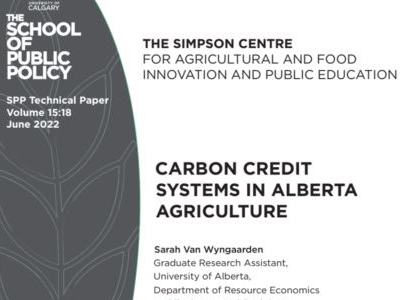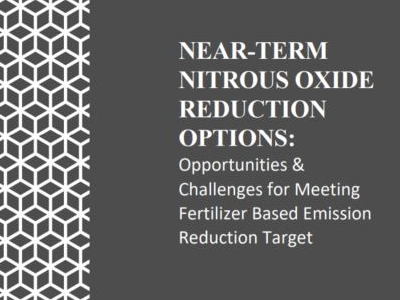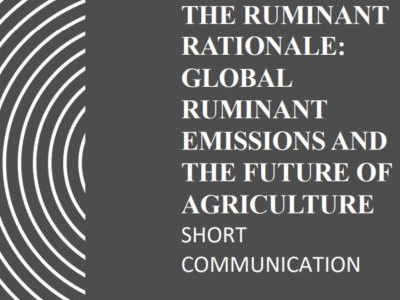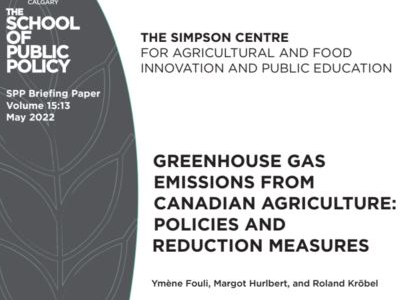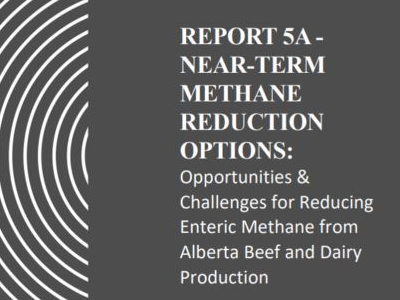Publications
The Pan-Canadian Framework was implemented in 2016 to help meet emission reduction targets set out by the Paris Agreement. Carbon pricing is at the foundation of this framework, where Alberta has used a carbon-credit market to reduce emissions from large-scale emitters. Agricultural producers voluntarily participate in these markets through agricultural carbon offset protocols; regulated emitters can purchase agricultural carbon credits to meet their emission reduction requirements. The main goal of these agricultural protocols is to reduce on-farm emissions through the adoption of best management practices (BMPs), alongside providing producers with the potential benefit of earning additional revenue by selling carbon credits on the market. While producers have participated in the market for quite some time, the impact of the market on Alberta agricultural producers is unknown. The main objective of this paper is to understand this impact by analyzing two considerations: 1) emission reductions (or removals) from agricultural protocols; and 2) economic benefits to producers from participating in the carbon offset market. After a case study of current agricultural carbon offset protocols, the results suggest producers are mainly participating for the economic benefits stemming from the adoption of BMPs, rather than the potential revenue from selling carbon credits on the market. Results also show protocols have high emission reduction potential, but this analysis was limited due to a lack of publicly available data. The most significant observation is that the majority of protocol emission reductions come from one protocol, the Conservation Cropping Protocol. The remaining agricultural protocols have seen minimal uptake in participation, specifically from livestock producers, which is concerning given the retirement of the Conservation Cropping Protocol on December 31, 2021. The main consideration will be addressing current protocol shortcomings to ensure producers are willing and able to participate in the market.
Tuesday, June 14, 2022
Sarah Van Wyngaarden
Increasing pressure to expand output while maintaining or decreasing input and land use has placed farmers in a difficult position. The increase in fertilizer use to support growing yields and soil deficiencies in Canada lead to a significant spike in nitrous oxide emissions over the past 18 years. In 2020, the federal government of Canada introduced the first emission reduction target specific to the agricultural sector, aiming for a 30 percent reduction of inorganic fertilizer-based emissions by 2030. Agriculture and Agri-Foods Canada released a discussion paper in 2022, supplementing the federal government’s target with practical strategies and recommendations for farmers to adopt with associated changes and trade-offs, in order to reach the target. This systemic review of meta-analytical studies based explores the potential impact of 4R stewardship adoption and other mitigation strategies, including biochar, irrigation, and the use of legumes in crop rotation, on N2O emissions in Western Canada. Results were mixed, likely due to the interrelationships between environmental and soil factors in the nitrogen and hydrological cycles. Overall, enhanced efficiency fertilizers were identified as the most advantageous and applicable practices, with less applicable practices like biochar and micro irrigation also reducing N2O emissions. In order to improve N2O emission measurements and reflect the adoption of all mitigation strategies, Canada’s N2O accounting methodology should be updated before the 2030 target deadline.
Friday, May 20, 2022
Joshua Bourassa, Luc Fourner, Elena Vinco
The role of domesticated ruminants on a global scale cannot be understated, despite sweeping generalizations that oversimplify complex and intricate cattle and livestock systems existing from local to multi-national levels. Grazing and mixed systems, predominantly in the global south, are a crucial and necessary component of rural socio-economic structures and provide a source of food security and livelihood for small-holder and sustenance farmers. Ruminant production, specifically the emissions associated with dairy and beef cattle production, is a highly polarizing and contentious topic in climate change discourse. Current and potential forthcoming challenges and opportunities will require changes and possible trade-offs, optimizing transition risk to ensure future stability and longevity. Going forward, novel technologies and advancements in animal breeding and animal diet can reduce emissions and contribute to global and national emission reduction targets.
Thursday, May 19, 2022
Elena Vinco
Current reports indicate that during the 21st century, global warming of 1.5° C and 2° C will be exceeded. Total greenhouse gas (GHG) emissions continue to increase in Canada, with the agricultural sector contributing approximately 10 per cent of these. Since GHG emissions are closely tied to population growth, it is imperative to act now to mitigate emissions because the agricultural sector is under pressure to increase production as the population grows. Estimates are that the world’s population will grow from 7.7 billion in 2019 to 9.7 billion by 2050. There is no one solution that will effectively mitigate GHG emissions in all regions. Different regions in Canada have different challenges and capacities to address their GHG emissions. Guidelines, programs, policies, and best management practices need to consider these regional differences to ensure their success. They also need to support sustainable development, food security, poverty eradication, justice, and equality. The key to designing successful regional policies is having carbon accounting programs that the industry is willing to use. Even though there are accounting schemes (globally, federally, and provincially), they are not consistent and have limited monitoring and verification of actual carbon reductions. In addition, producers do not use them due to the large amounts of paperwork and small economic benefit. Regularly monitored, seamless carbon accounting programs can be adopted within subsectors of the agricultural industry and within similar climatic regions to help determine potential carbon sinks and opportunities to minimize GHG emissions, as well as identify best policies for each region and subsector. Data from carbon accounting programs need to be shared and communicated to help align industry, provincial and federal GHG inventory programs. These data need to be included in the National Inventory Report for a better overall view of GHG emissions and the effects on them of programs and policies. 2 Adoption of a federal, provincial, and municipal carbon tax can also be an effective solution but there are many barriers to the carbon tax, including general public opinion. To make the carbon tax successful, there must be increased communication between policy-makers, agri-businesses, and the general public to help identify contexts and barriers to its adoption. Successful measures and practices for reducing agricultural GHG emissions tend to support technological solutions and do not face significant barriers to uptake, such as no-till practices, optimizing animal feed and additives, feed grain processing for improved digestibility and genetic selection and breeding, to name a few. Many of these techniques are already supported by provincial best management practices and farm stewardship programs. Finding policy solutions that increase farm net income while reducing GHG emissions in Canada is possible and will be the most successful. A few modeling tools are currently available to producers to assess GHG emissions of a variety of land uses and farm activities. The more user-friendly the models are, the more producers and businesses will use them, and the more data will be captured and used to improve GHG emission estimations and predictions, and mitigate GHG emissions from Canadian agriculture.
Wednesday, May 04, 2022
Ymène Fouli, Margot Hurlbert, and Roland Kröbel
The reduction of greenhouse gas emissions is a global goal across sectors. Methane, an especially potent greenhouse gas relative to carbon dioxide, is the target of the Global Methane Pledge, an undertaking by over 100 countries to reduce methane emissions by 30 percent by 2030. The agricultural sector is uniquely positioned to support Canadian methane reductions through mitigation of enteric fermentation in cattle. Enteric fermentation in dairy and beef cattle contribute to over 85 percent of methane emissions from the agriculture sector. Different mitigation strategies and technologies have demonstrated variable effect on methane reduction, depending on factors related to cattle diet, management, and operational practices. Relevant research and literature based on criteria related to potential application in western Canada and Canadian cattle production in the beef are dairy sector was collected and reviewed using PRISMA approach. Research in the beef and dairy sector were divided and compiled into separate databases to determine the most effective and impactful mitigation strategies. Overall, the use of 3NOP and marine algal strains as dietary additives were identified as the most promising technologies in reducing enteric fermentation, without negatively impacting production markers and subsequent profit. Tanniferous legumes as a forage also shows promise, however current findings in research demonstrate mixed effects on various production markers in dairy and beef cattle. Other mitigation strategies identified through the review process, including the use of various natural and synthetic dietary additives, require further investigation as inconclusive and insignificant results are predominant. To drive adoption of methane reduction strategies by farmers, introduction of the mitigation technologies and strategies discussed must align with Federal and Provincial policy development and implementation and ensure sufficient profit to producers, potentially through the sale of carbon offsets as the market development, in order to cover additional costs of adoption and incentivise use. Prompt introduction and adoption of the mitigation strategies discussed can effectively reduce enteric methane emissions in Canadian cattle herds, propelling Canada towards the 30 percent emission reduction goal in time for 2030.
Saturday, April 30, 2022
Courtney Kowk, Elena Vinco
Joshua Bourassa and Elena Vinco
Thursday, April 21, 2022

